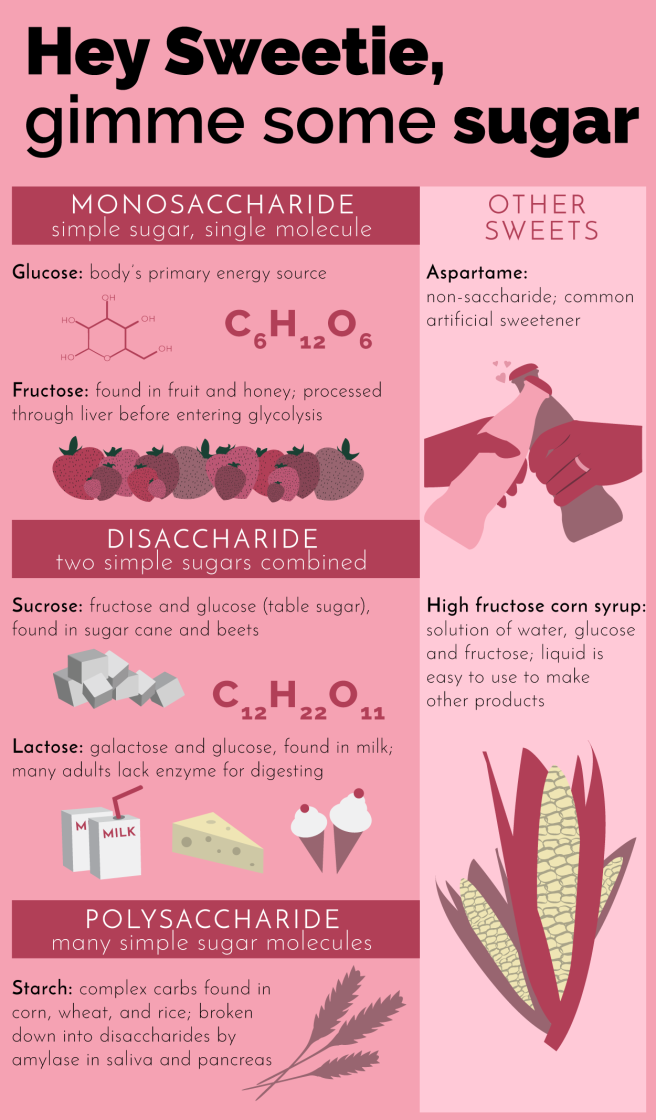Today is Valentine’s Day, which means you might have just spent the morning rushing around for last minute treats to gift to your loved one. But not all sweet treats are made alike. What is the difference between sugar, artificial sweeteners, and that old American favorite, high fructose corn syrup? And what happens when we try to digest them?
Chemically, sugars are a type of carbohydrate, a compound made from chains of carbon, oxygen, and hydrogens. Carbohydrates are also sometimes called saccharides, and they serve a range of functions in the body, including storing energy. They are classified by how long their chains are. Monosaccharides, also known as simple sugars, are a single unit of a chain. These monosaccharides are chained together to form other, more complex sugars. For example, refined or table sugar is made from sucrose, a disaccharide comprised of fructose and glucose, both monosaccharides. Sucrose can be refined from cane plants or from sugar beet and is a source of pure carbohydrates. There are also oligosaccharides and polysaccharides, which are made of even longer chains of simple sugars. When the more complex sugars are broken down in the body, they are broken down into their constituent monosaccharides, or for the longer and more complex carbohydrates, even disaccharides or oligosaccharides (3-10 units).

Sucrose is a sweetener found in nature, but we can also manufacture other saccharide-based sweeteners. An example of this is high fructose corn syrup. It was developed because syrups are easier to handle than powders on a large scale, because they pour out better and are more containable. High fructose corn syrup is made from corn starch. Enzymes break down starch into fructose and oligosaccharides. Another enzyme, glucosidase is added to convert everything to glucose. Glucose and fructose have the same chemical formula—they have the same number of carbons, hydrogens, and oxygens but they are arranged differently. Glucose can be converted to fructose, and is even done so in the body. High fructose corn syrup, then, is a mixture of water, glucose, and fructose made from glucose.
Perhaps the most [in]famous of artificial sweeteners is aspartame, which can be found in Diet Coke.
There are also artificial sweeteners, food additives designed to add sweetness without the additional Calories. Perhaps the most [in]famous of artificial sweeteners is aspartame, which can be found in Diet Coke and commercially as NutraSweet. Aspartame is a methyl ester of a dipeptide, which means it is made of two amino acids with an additional group stuck on the end. The structure of aspartame is very different from sugar, especially metabolically since it is made of protein subunits.
Aspartame is broken down very quickly in the body into aspartic acid, phenylalanine, and methanol. The former two are essential amino acids, and the methanol is eventually converted into formic acid, which passes through the body. All three could be toxic in large quantities, but numerous studies suggest that aspartame is safe for human health. However, because it’s broken down so quickly and contains none of those high energy carbs, aspartame and other artificial sweeteners satisfy a sweet tooth without any Caloric benefit (depending on your point of view).

So, what happens when we eat something with real sugar, ie saccharides, in it? Let’s take a Sweetheart, made from sugar, corn syrup, gelatin, gums, coloring and flavoring. For some sugars, digestion starts in the mouth. Amalyses in the saliva break down complex starches into disaccharides, which are then eventually cleaved into glucose. The corn syrup might have some residual starch, so some will be broken down here. The sugars will continue their way down the digestive track to the small intestine, where they encounter the enzyme sucrase. Sucrase breaks the sucrose into fructose and glucose. At this point the two diverge. Fructose must pass through the liver, where it’s converted into a variety of products, including glucose and lactate. Eating sugar causes a temporary spike in blood glucose or blood sugar levels, which is used by cells as an energy source. Glucose is converted into usable energy, or metabolized, through a series of complicated mechanisms called glycolysis and the Krebs cycle. You can read more here. The gist is, the glucose is oxidized and after a series of reactions makes CO2, water, nitrogen compounds and Gibbs free energy which can be used by the cells to function.
The different sugars we eat affect our body differently. High fructose corn syrup, which has a high amount of free fructose, puts a higher demand on the liver than normal sugar. Aspartame passes through the body with little metabolism at all. So today, when you give chocolate or candies to your loved one, tell them about the metabolism of sugars—I’m sure they’ll appreciate you for it 🙂
